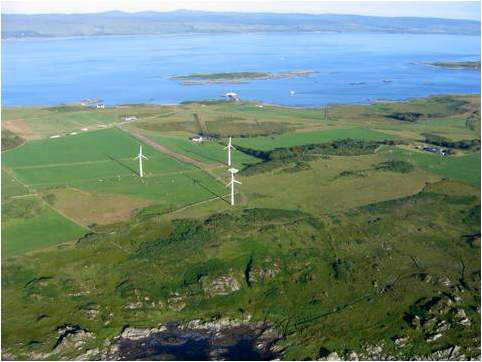“Who has seen the wind?” asks 19th-century author Christina Rossetti in her poem of the same name.
Her answer? “Neither I, nor you … but when the leaves hang trembling, the wind is passing through.”
“Who has seen the wind?” she ponders again in the second stanza. “Neither you, nor I … But when the trees bow down their heads, the wind is passing by.”
It’s true that none of us has actually seen the wind, only its effect on things. Yet, standing at the feet of Gigha’s so-called ‘Dancing Ladies’, I feel emboldened to dispute Rossetti’s conclusion.
For as the shadows of the wind turbines’ rotating blades skip rhythmically across my boots, their song ringing in my ears, it is indeed as if I am seeing the wind itself.
Within almost touching distance of these iron giants, it also dawns on me that until now I’ve never truly appreciated their awesome power. Up close like this, however, the force of mother nature is brutally overwhelming.
I feel instantly insignificant and am reminded of Macbeth’s famous line: “Out, out, brief candle! Life’s but a walking shadow, a poor player that struts and frets his hour upon the stage and then is heard no more.”
Everywhere we go on this, the “nearest and fairest” of the Hebrides, situated just three miles west of Argyll’s Kintyre Peninsula, there are references to the wind.
“We cannot direct the wind but we can adjust the sails,” reads the header on the notice board by the pontoon leading out to the moorings in Ardminish Bay.
And I giggle immaturely (which I suspect is exactly what the owner had in mind) as we walk past a small boat with the words “Passing Wind” emblazoned on its stern. Top marks to whoever came up with that name.
But jokes aside, it’s hardly surprising that wind is such a common theme during our unseasonably sunny day trip across the water, given its vital importance to this special place. Bought by the community in 2002, Gigha, which the Vikings called The Good Isle or God’s Isle, has had a grid-connected windfarm since 2004.
Three second-hand Vestas V27 turbines, christened Creideas, Dochas and Carthanna (or Faith, Hope and Charity in English), were initially installed. A fourth one, Harmony, this time a new Enercon E33, joined them on the westerly-facing southern slopes in 2011.
Described by some as the catalyst for the island’s recovery, any profits from the power generated are ploughed into maintaining and improving it. And while Gigha has had its share of challenges – notably significant financial hurdles – it now appears to be doing better.
The story is a heartening testament to what can be achieved by determination and hard work. More widely, however, the sector is facing an uphill struggle, with new onshore wind installations falling by 80% last year to their lowest level since 2011.
This worrying drop undoubtedly has its roots in the UK Government’s decision after the 2015 general election to stop onshore wind companies from competing for subsidies.
Encouragingly, in May, UK Energy Minister Claire Perry insisted her party is “absolutely not against onshore wind”. The following month a policy tweak was agreed to enable projects which are built on remote islands to bid for support, although otherwise firms remain locked out.
They are also excluded from going up against other technologies for government backed power contracts, a situation which industry has warned is hampering the development of subsidy-free schemes.
The rationale for the Tory stance, which stands in contrast to the Scottish Government’s ongoing backing for onshore wind, was a manifesto pledge to “halt the spread of onshore wind farms“ which “often fail to win public support”. Yet in July, a YouGov poll found 66% of voters would support a change of direction allowing onshore wind farms to be built in places where they have local approval.
With that in mind, maybe the time has come to look at this again.
To me the windmills are majestic monoliths with a strange hypnotic beauty and I love that they look different depending on the weather or the time of day.
Clearly they aren’t to everyone’s tastes, however, and it’s not difficult to understand residents’ motivation for objecting when projects are planned near their homes. Some would be quick to dismiss this as nimbyism, but it’s not unreasonable to worry about the appearance of your surroundings.
There may also be legitimate practical concerns around issues like the readiness of local infrastructure to cope with the transport of the huge parts that make up the turbines.
All that said, where communities are on board or at least agree to be compensated – and with Scenic Areas and National Parks obviously protected – we can’t afford not to exploit opportunities at suitable sites.
Amid concerns of a looming energy gap as older methods of generating power are retired and in light of the UK’s commitment to reduce its carbon emissions under the Paris Agreement, we need to invest in varied energy sources, with a sharp focus on renewables going forward.
Widely recognised as the cheapest way of generating new power, onshore wind already produces enough electricity to meet the annual needs of several million homes a year. The technology must be allowed to fulfil its potential and secure its rightful place in the UK’s energy mix.
Lindsay Razaq is a journalist and former P&J Westminster political correspondent who now combines freelance writing with being a first-time mum
